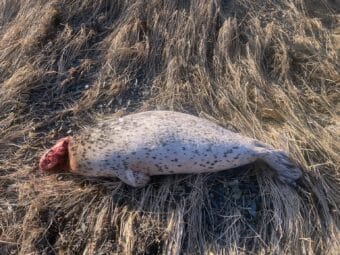
An unusual bird was sighted in the Yukon Flats village of Chalkyitsik recently. The raptor, uncommon to the state, has also been spotted in a few other Alaska locations.
Chalkyitsik resident Kyle Joseph says his uncle told him about seeing a strange looking bird.
“He said there was a weird eagle flying around and it had a red beak, and I was like, ‘Oh, OK.'”
Joseph says he later spotted the bird while helping his aunt cut firewood.
“It flew by, and it was like nothing I had ever seen,” he said.

Joseph says the bird landed on a cache and he was able to get close.
“I slowly walked up to and took a picture of it, and I was like, ‘What the heck,'” he said. “And then I looked it up, and it was a turkey vulture.”
Turkey vultures survive on carrion. Joseph suspects the bird was drawn in by a pile of moose meat scraps.
“It looked like someone had dropped their waste back near the lake for the crows and stuff. And it would just fly over their, pick up a little chunk of meat and fly up into the trees,” he said.
Joseph says he posted about the sighting on Facebook and has received a lot of comments.
“Nobody’s ever seen a vulture in our area before,” he said.
U.S. Fish and Wildlife Service migratory bird biologist Jim Johnson says the Chalkyitsik turkey vulture sighting was preceded by a sighting earlier this year in the Northwest Alaska village of Noatak, and later in Juneau, as well as a few earlier year observations as far north as Utqiagvik.
“With their bright red, featherless heads, you just can’t mistake them for anything else,” he said.
Johnson says although the bird’s normal range only extends to southern Canada, turkey vultures are migratory raptors built to fly long distances.
“They’re really fascinating birds. They weight about three pounds and have six-foot wingspans, which enables them to ride thermals or rising warm air, and it’s not unusual for a bird to be able to travel 100-200 miles per day without flapping, just soaring,” he said.
Predisposed to marathon travel in search of carrion, Johnson suspects the turkey vultures spotted in Alaska follow geographic corridors north.
“Entering our state via large river systems or following the slopes of large mountain ranges like the Alaska Range,” he said.
Johnson says there’s broader evidence that the nomadic turkey vulture is expanding north, adding that Alaska is a place where migratory birds often show up outside their normal ranges.
“Alaska is really a nexus for birds from all over the world,” he said.
Johnson notes that there are hundreds of birds uncommon to Alaska that sporadically show up in the state, but many less distinctive species go unnoticed.
He applauds observers like Kyle Joseph of Chalkyitsik for taking a picture of the turkey vulture and sharing it.



